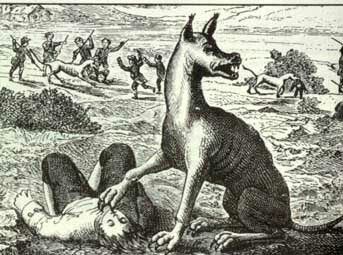
The Mysterious Man-Eating Beast of Gévaudan, and the Hunters Who Killed It
The region of Gévaudan, located in southern France in what is now Lozère, was particularly vulnerable when the Beast arrived. The population consisted mainly of impoverished and defenseless peasants, with women and children responsible for herding livestock. Wolves were prevalent in the area, often preying on livestock and occasionally on the herders themselves.
The Beast made its first documented kill on June 30, 1764, when a 14-year-old shepherdess was found partially eaten in the woods. This was followed by a series of similar gruesome deaths, mainly targeting women and children, especially girls.
The Beast terrorized Gévaudan for three years, claiming over 100 lives and leaving many others injured. Survivors described the Beast as resembling a wolf but not entirely. The superstitious peasants, believing in creatures like witches and werewolves, soon speculated that Gévaudan was under attack from something far more sinister than a normal wolf.
A Menagerie of Monsters
Witness accounts of the Beast of Gévaudan varied greatly. It was often described as hairy, with a black stripe running along its backbone. While bearing some resemblance to a giant wolf, it had distinct characteristics that set it apart. It was initially referred to as a “hyena” in newspapers, but as time went on, it was compared to a panther, tiger, lion, monkey, hybrid, or even a mad man in a wolf suit.
Some speculated that the Beast was an unknown species from ancient times, possibly brought from Africa and later escaped or released. Another theory suggested that it was an armored mastiff being directed by its handler to prey on victims.
Many historians believe that the Beast was actually a wolf, potentially a wolf-dog hybrid. These animals, lacking fear of humans, have been responsible for numerous attacks on people. However, the peasants of Gévaudan remained steadfast in their belief that the Beast was a werewolf or some other monstrous creature, fueled by the bishop of Mende proclaiming it as a divine punishment upon the region.
A Legend Is Born
The legend of the Beast of Gévaudan has captured the fascination of France and beyond. The story continues to inspire books, articles, and movies, ensuring its enduring fame.
During the Beast’s reign of terror, the media capitalized on the sensational story. Newspapers and journals, hungry for content after the Seven Years’ War, used the Beast as a way to captivate readership.
In his book “Monsters of Gévaudan: The Making of a Beast,” author Jay M. Smith explores how the Beast offered a reprieve from the war and allowed France to reestablish its national identity. The beast became the subject of obsession and the hunt for it consumed the collective consciousness.
The legend of the Beast of Gévaudan lives on in France today. Modern depictions portray brave peasants fighting off the ferocious creature.
The Hunters and the Hunt for the Beast

Four main hunters participated in the pursuit of the Beast of Gévaudan.
The first was Jean-Baptiste Duhamel, a dragoon captain tasked by King Louis XV to find and kill the Beast. Despite the initial expectation of a swift victory, Duhamel soon discovered the rugged landscape, harsh weather, and the cunning of the Beast posed significant challenges. Duhamel organized large-scale hunts, including the use of women and children as bait to lure the Beast, as it primarily targeted them.
The reward for the Beast’s head reached an astonishing amount, attracting adventurers from far and wide. Sightings occurred, and the Beast seemed to have been wounded on multiple occasions, but always managed to escape.
Following Duhamel’s failure, Jean-Charles d’Enneval and his son, renowned wolf hunters from Normandy, took over. Despite their reputation, they were unable to put an end to the Beast’s reign of terror. The frustrated d’Ennevals eventually left Gévaudan, convinced that the Beast was no ordinary creature.
The next hunter was François Antoine, a 70-year-old Lieutenant of the Hunt for the King. Antoine dismissed the fantastical stories surrounding the Beast, believing it to be an exceptionally large wolf and that other predatory wolves might be present in the area.
On September 20, Antoine encountered the Beast near the Abbey of Chazes. He managed to shoot and kill it, confirming it to be an unusually large and strange-looking wolf. The Beast’s reign of terror finally came to an end. Antoine claimed to have also eliminated the rest of the wolf pack.
The Beast’s Final Resting Place
Newspapers reported the Beast’s demise, but after two months, it became apparent that attacks were still occurring. Official reports downplayed the phenomenon, treating it as a generalized problem requiring attention.
Poisoning was widely used to kill wolves with great success, but the Beast remained relentless in its attacks.
In the spring of 1767, the Beast continued to prey on the villagers of Gévaudan on a weekly basis. Despite efforts to combat it, the Beast proved to be resilient. Thirteen deaths occurred between March and May 1767, including children, teenagers, and an adult.
The enigmatic Jean Chastel, a resident of Gévaudan, emerged as the fourth and final hunter of the Beast. Various theories link Chastel and his son to the Beast, with some proposing that his son’s trained mastiff could have been responsible for the attacks. Chastel killed a large and peculiar-looking wolf on June 19, 1767, using bullets melted from a blessed silver medal. Witnesses described the creature as monstrous, with eerie eyes, black and red fur, and unusual proportions.
Although Chastel received no formal recognition, he became a legendary figure, depicted as both a hero and a werewolf. With his Beast slain, the killings in Gévaudan ceased.
At least one of the Beasts of Gévaudan was preserved by a taxidermist. However, those who saw the stuffed Beast found it underwhelming and even comical. It was eventually discarded and forgotten.
Years later, researchers sought the Beast at the museum where it had been stored, only to discover that it had been mistaken as trash and thrown away.

A skilled hunter, dedicated conservationist, and advocate for ethical practices. Respected in the hunting community, he balances human activity with environmental preservation.
